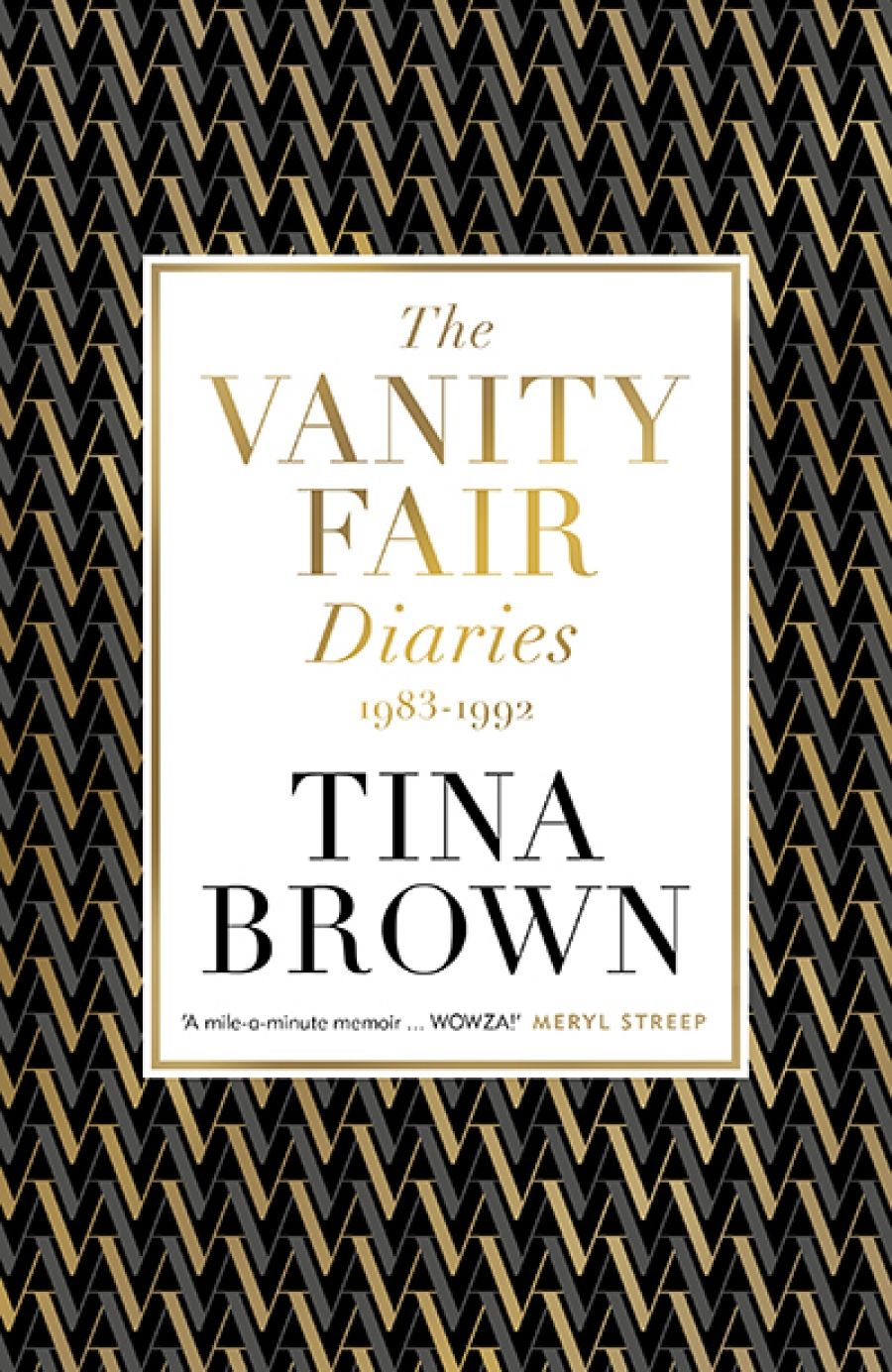
- Free Article: No
- Contents Category: Memoir
- Custom Article Title: Susan Wyndham reviews 'The Vanity Fair Diaries: 1983–1992' by Tina Brown
- Custom Highlight Text:
Tina Brown hit the ground partying in New York when she arrived in 1983 to revive the struggling Condé Nast magazine ...
- Book 1 Title: The Vanity Fair Diaries
- Book 1 Subtitle: 1983–1992
- Book 1 Biblio: Weidenfeld & Nicolson, $29.99 pb, 438 pp, 9781474608404
What did last, and makes Brown’s diaries a wicked pleasure to read, is her amused observation of everyone she met, enhanced by her energetic, reflective, and often prescient prose. As first-draft history of an era of unashamed wealth and power, by a writer with rare insider-outsider status, this is gold dust.
I could fill pages with the bullseye portraits that suggest Brown had a tape recorder but probably just a sharp, imitative memory. Mick Jagger and Jerry Hall ‘looked like Satyricon creatures at a Venetian carnival with a whiff of decadence you only see as you get close’. Millionairess Jayne Wrightsman ‘gave the Kissingers a tractor for Christmas for their house in Connecticut’. Norman Mailer ‘sat with his legs akimbo like a macho koala, eyes twinkling with satire’. Philip Roth, in person, is ‘like an accountant’. The recurring property developer Donald Trump, his ‘pouty Elvis face folded into a frown of self-castigation’, half-charmed Brown until he poured a glass of wine down the back of a critical journalist. A ‘crazed’ Jacqueline Onassis, also offended by the magazine, launched an attack on Brown over dinner that she details in all its ‘deft and understated malice’. And so on and on.
Brown did not emerge into this stratosphere from nowhere. The daughter of a British film producer and a former assistant to Laurence Olivier, she was a discerning social creature, thrown out of several schools for ‘crimes of attitude’. She thrived at Oxford, where she had a play chosen for the Edinburgh Festival and a romance with ‘the small and Jaggeresque’ Martin Amis.
Wisely, she married Harold Evans, her editor at The Sunday Times, after an affair that propelled her move to Tatler. She gave the languishing society magazine a sassy revamp focused on her ‘chocolate-box’ lookalike, Princess Di. After Rupert Murdoch fired Evans in 1982, the couple was ready to take on the high-stakes challenge of New York. Murdoch haunts them as a villainous shadow and, when they become power brokers, a social acquaintance whose ‘face has degenerated to the melting rubber mask of a cartoon character like Nixon’s’.
Evans gave Brown entrée to ranks beyond most magazine editors. But her own instincts and determination drove circulation and eventually ad sales to heights that made her the hottest editor in town. Photographer Harry Benson’s portraits of President Reagan and his wife Nancy clutched in a foxtrot and a kiss turned the couple into ambassadors for the magazine. Annie Leibovitz shot cover after memorable cover, pushing sales over a million with a naked, pregnant Demi Moore.
 Tina Brown (Wikimedia Commons)Much of the book follows Brown’s own foxtrot with proprietor Si Newhouse, as she negotiates herself into the editorship of Vanity Fair and then – as her taste veers to the big news stories of the 1990s – The New Yorker. She flirts with other employers, woos and fires staff, creates the magical story mix of high and low, froth and substance, and makes the odd blunder among the triumphs. All this may intrigue media junkies more than other readers, but it is as frank a behind-the-scenes business report as I have ever read, and a reminder of the age of letters and faxes, when deals were done over lunch.
Tina Brown (Wikimedia Commons)Much of the book follows Brown’s own foxtrot with proprietor Si Newhouse, as she negotiates herself into the editorship of Vanity Fair and then – as her taste veers to the big news stories of the 1990s – The New Yorker. She flirts with other employers, woos and fires staff, creates the magical story mix of high and low, froth and substance, and makes the odd blunder among the triumphs. All this may intrigue media junkies more than other readers, but it is as frank a behind-the-scenes business report as I have ever read, and a reminder of the age of letters and faxes, when deals were done over lunch.
Brown’s nose for the Zeitgeist and passion for her work are awe-inspiring. Yet as a journalist who laboured many rungs down the New York ladder in those years, I am struck by her unawareness of how high she lived. The society dinners, limousines, Hamptons weekender, money thrown at problems made me need breaks from the book, craving tea-and-toast simplicity as I once did on a junket in France, where dinner was always Champagne and foie gras.
As unexpected as her magazine, however, Brown declares an introverted side to her nature, a yearning for a quiet, bookish family life and nostalgia for witty old England. The births of her premature son (later diagnosed with Asperger’s syndrome) and daughter tear her between love and guilt. She worries about her distant parents and mourns friends struck down by AIDS. But in the next sentence she is overseeing Vanity Fair’s fifth-anniversary party or admitting ‘I can executive-produce dinner, it seems, but can’t cook it’.
‘I rethink my life for the millionth time,’ she writes on March 17, 1988. ‘Why do I keep seeking out the very things I deride? Perhaps because I was born to chronicle them.’ That is excuse enough for such a talent. Let’s hope she kept her diaries from The New Yorker years.


Comments powered by CComment